The AMD A8-7650K APU Review, Also New Testing Methodology
by Ian Cutress on May 12, 2015 10:00 AM ESTOffice Performance
The dynamics of CPU Turbo modes, both Intel and AMD, can cause concern during environments with a variable threaded workload. There is also an added issue of the motherboard remaining consistent, depending on how the motherboard manufacturer wants to add in their own boosting technologies over the ones that Intel would prefer they used. In order to remain consistent, we implement an OS-level unique high performance mode on all the CPUs we test which should override any motherboard manufacturer performance mode.
All of our benchmark results can also be found in our benchmark engine, Bench.
Dolphin Benchmark: link
Many emulators are often bound by single thread CPU performance, and general reports tended to suggest that Haswell provided a significant boost to emulator performance. This benchmark runs a Wii program that raytraces a complex 3D scene inside the Dolphin Wii emulator. Performance on this benchmark is a good proxy of the speed of Dolphin CPU emulation, which is an intensive single core task using most aspects of a CPU. Results are given in minutes, where the Wii itself scores 17.53 minutes.
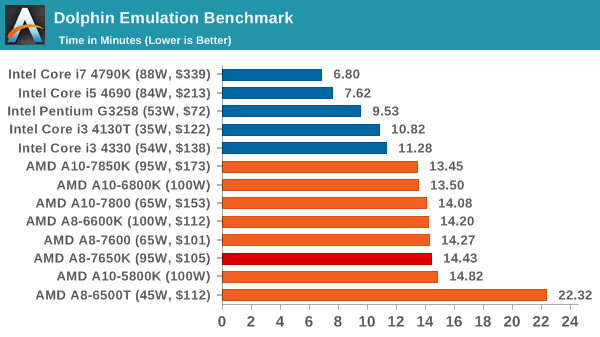
Dolphin likes high IPC and clock frequency, which indicates that the highest clocked APUs perform the best out of AMD here. Because the benchmark is single threaded, even a dual core Intel wins though.
WinRAR 5.0.1: link
Our WinRAR test from 2013 is updated to the latest version of WinRAR at the start of 2014. We compress a set of 2867 files across 320 folders totaling 1.52 GB in size – 95% of these files are small typical website files, and the rest (90% of the size) are small 30 second 720p videos.

The varied-thread workload of WinRAR seems to vary between the dual core Intels and the dual module AMD chips, showing that threads matter.
3D Particle Movement
3DPM is a self-penned benchmark, taking basic 3D movement algorithms used in Brownian Motion simulations and testing them for speed. High floating point performance, MHz and IPC wins in the single thread version, whereas the multithread version has to handle the threads and loves more cores.

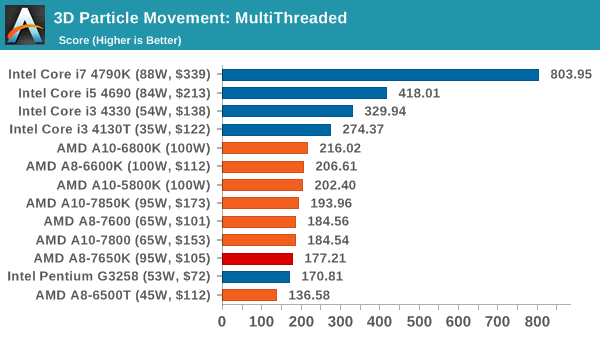
In this nieve benchmark, the compiler prefers x87 style commands which AMD's Bulldozer based architectures isn't too fond of. This benchmark is meant to be a representation of crude scientific code, similar to that used in a research lab. Ultimately, Bulldozer architectures such as Kaveri prefer specific commands, especially when dealing with basic math.
FastStone Image Viewer 4.9
FastStone is the program I use to perform quick or bulk actions on images, such as resizing, adjusting for color and cropping. In our test we take a series of 170 images in various sizes and formats and convert them all into 640x480 .gif files, maintaining the aspect ratio. FastStone does not use multithreading for this test, and results are given in seconds.
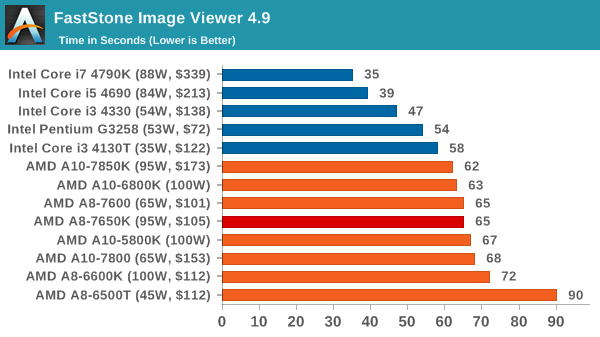
Web Benchmarks
On the lower end processors, general usability is a big factor of experience, especially as we move into the HTML5 era of web browsing. For our web benchmarks, we take four well known tests with Chrome 35 as a consistent browser.
Sunspider 1.0.2

Mozilla Kraken 1.1

WebXPRT
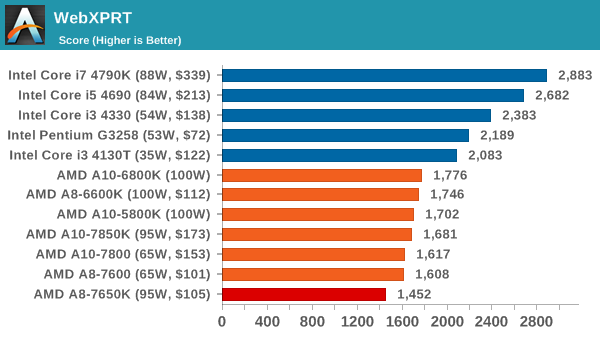
Google Octane v2
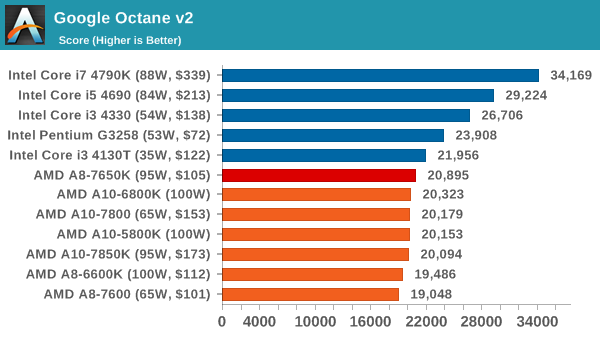










177 Comments
View All Comments
silverblue - Thursday, May 14, 2015 - link
I've often wondered if the G3258 is really the better choice in this price range. Sure, there are titles it cannot play, but workarounds exist in one or two titles to allow it to work. Newer titles may indeed render it obselete, but there's always the argument about buying a better CPU for the platform later on. Additionally, it overclocks like buggery if you feel that way inclined; how long has it been since we had a CPU that could be overclocked by 50% without costing the earth in power?The concern I have with upgrading just the CPU is that Intel doesn't stick with its sockets for a long time, and if you're buying a CPU that will eventually become as useful as a chocolate fireguard when playing modern titles, it'd make more sense to buy its i3 cousins in the first place. AMD is banking on you considering its quad core APUs for this, however they have their flaws too - FM2+ has a year left (Carrizo is destined for FM3 along with Zen), they don't overclock as well, power usage is higher even during idle, and the GPU-less derivatives don't appear to be any faster. H81 boards aren't expensive, either, for overclocking that Pentium. Still, you really do need a discrete card with the G3258/Athlons, whereas the APUs and i3 have enough iGPU grunt to go into an HTPC if you're not gaming heavily.
Decisions, decisions... and right now, I'm wondering how I could even consider AMD. Has anybody made systems for both Pentium and Athlon/APU systems and can share their thoughts?
Tunnah - Tuesday, May 12, 2015 - link
Nice review, covers pretty much everything, and says what I guess everyone was expecting.One thing I wondered though, why choose the 770 for mid-range when the 960 is a much more logical choice ? Price wise it's £140 here in UK so I guess about $200 over the pond, and is a much more competent card than the 770
Ian Cutress - Wednesday, May 13, 2015 - link
Because I've had 770s in as part of my test bed for 18 months. The rest of the cards (290X, 980, 285) I've sourced for my 2015 testing, and it's really hard to source GPUs for testing these days - I had to personally purchase the 285 for example, because I felt it was extremely relevant. Unfortunately we don't all work in a big office to pass around hardware!meacupla - Wednesday, May 13, 2015 - link
If you do ever get a GTX 960 or 750Ti, it would be nice to see some total system power consumption numbers between overclocked A8-7650K+R7 240 vs. i3-4xxx+750Ti vs. overclocked G3258+750TiDrazick - Wednesday, May 13, 2015 - link
Hello,Could you please add MATLAB to your performance benchmark?
Or at least Python / Julia.
We need data about scientific computation.
Thank You.
UtilityMax - Wednesday, May 13, 2015 - link
"Scientific computation" is a somewhat amorphous term. Moreover, I don't know if there exists a benchmark suite for either Matlab or Python. In any case, Matlab and Python or both used in numerics as fast prototyping tools or for computations where the compute time is inconsequential. If you're running in speed issues with Matlab it's time to start coding in something else, although in from my observations, most people who run into performance issues with Matlab don't know how to optimize Matlab code for speed. Most don't know how to code at all.freekier93 - Wednesday, May 13, 2015 - link
Your really don't know what you're talking about... Matlab is SO much more than fast prototyping software. I have quite a few programs what would be good speed tests, one of which being a full non-linear aircraft dynamics Simulink simulation. A 5 minute simulation could easily take 2 minutes of compute time. Anything that starts getting into serious differential equations takes compute time.Ian Cutress - Wednesday, May 13, 2015 - link
3DPM is a Brownian Motion based benchmark, and Photoscan does interesting 2D to 3D correlation projections. The Linux benchmarks also include NAMD/NPB, both of which are hardcore scientific calculations.Smile286 - Wednesday, May 13, 2015 - link
Author, do you know about existence of 'Haswell Refresh' CPU models? It's basically the same 'Haswell' with +100/+200/+300 MHz to their x86-core's speed. Why not use them in tests? It's not like it's 2013 right now, when i3-4330 was released. FYI, i3-4370 have the same $138 MSRP (tray) as i3-4330, but it +300 MHz faster.Same story about i3-4130 and i3-4170: +300 MHz for i3-4170 basically for free.
You should put them in test rather an old 'Haswell' core i3 models. Thanks.
zodiacfml - Wednesday, May 13, 2015 - link
How could a next generation API improve AMD's APU performance if it already has decent if not very good performance in integrated 3D graphics (beating the lowest end discrete)?AMD still needs better CPU performance as it shows poorer value compared to an Intel of near or similar price (without considering the GPU).
The occasional gaming niche is pretty nil too as that kind can be accomplished in a notebook, tablet, or smartphone.
This remains valuable for people with regular gaming in mind but with absolutely limited budget. I see myself getting this for getting back into Diablo 3 after a day from work but saving a bit more, I might as well get a decent laptop.